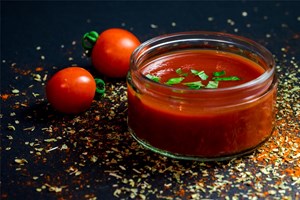Sign up to be notified of our new blog posts.
Sauce Manufacturing: Be Sure to Consider These When Choosing Your Processing Equipment
Posted on June 10, 2020

Summary: With the sauce manufacturing sector growing each year, selecting the right equipment is crucial for optimizing consistency, product quality, and processing efficiency. This article explores the key factors that food manufacturers should consider when designing or upgrading their sauce processing systems, from viscosity and ingredients to heating methods and agitation techniques.
The sauce category within the food manufacturing industry is growing about 4.1% per year, spurring product innovation from both small and large processors. To make sure their production keeps pace, smart operators are considering how their product’s unique characteristics should influence equipment choices.
Processing vessel options can be as varied as the sauces themselves, with many design choices that will impact your product’s quality, consistency and production efficiency. Are you better off with a tank or hemispherical kettle? Unidirectional steam or circulated water heating? Inclined agitation or horizontal ribbon blending? To help you decide what’s best for your sauce processing operation, be sure to consider these factors:
Key Sauce Processing Factors
- Product viscosity is the first major consideration. A low-viscosity sauce with just a few easy-to-process ingredients may require only a basic vertical vessel and propeller mixer combination. Higher viscosity sauces may demand a more powerful motor to drive your mixer. Pairing an inclined agitator with a hemispherical kettle will also keep all the ingredients moving and cooking evenly, which is especially important with high-viscosity sauces.
- The ingredients in the sauce recipe will also dictate several design choices. Sauces with certain powdered ingredients, like flour, brown sugar, spices or bulking agents tend to develop “fisheyes”—small clumps of unmixed material with dry centers—that require powerful mixing action to disperse. Your sauce processing vessel may need a built-in propeller-type mixing unit for high-speed mixing and a scraped-surface agitator for constant, slower-speed stirring during cooking and processing. This combination will produce the powerful mixing action needed to handle most variations.
- Unique sauce conditions can also dictate the vessel performance and mixing method needed to most efficiently manufacture your product. For example, dairy-based sauce products, like cheese sauces cooked and blended in the vessel, demand scrape-surface sidewall agitation to prevent burn-on during cooking. Direct steam injection can also be used to avoid burn-on, infusing culinary steam directly into the product from steam injectors installed in the processing vessel.
- Mixing speed is another important processing consideration. The right mixing and agitation performance can shorten and improve your cooking process, since well-mixed and blended sauces will cook more consistently. Salad dressings and other sauces containing combinations of oil, vinegar, water or other liquids can sometimes separate during packaging. High-shear blending reduces oil and liquid droplets to a very small size to overcome separation.
- Tomato-based sauces can also require aggressive mixing due to the thick tomato paste used as the primary ingredient. This can be achieved by using a pre-mixing tank with a heavy-duty double-motion agitator to dilute and blend the tomato paste into a consistent slurry before transferring it to the main processing vessel.
- Heating and cooling requirements can be another important processing consideration for some sauce products. Sauces used in frozen foods are both heated in the vessel during cooking and then cooled in preparation for packaging. In these situations, the construction and quality of the vessel’s heating and cooling jacket is critical. A Lee’s highly efficient Uniflow coil jacket design can eliminate potential jacket and vessel leaks common to less robust dimple jacket designs.
The earlier in your equipment configuration stage that you can recognize and solve for the processing challenges unique to your sauce, the better you can set yourself up for operational success. Contact us if you’d like to discuss your situation with a Lee applications engineer. We’d be happy to help you make the most of the growing sauce processing market.
Last Updated: 10/29/2025
Comments
Add Your Own Comment